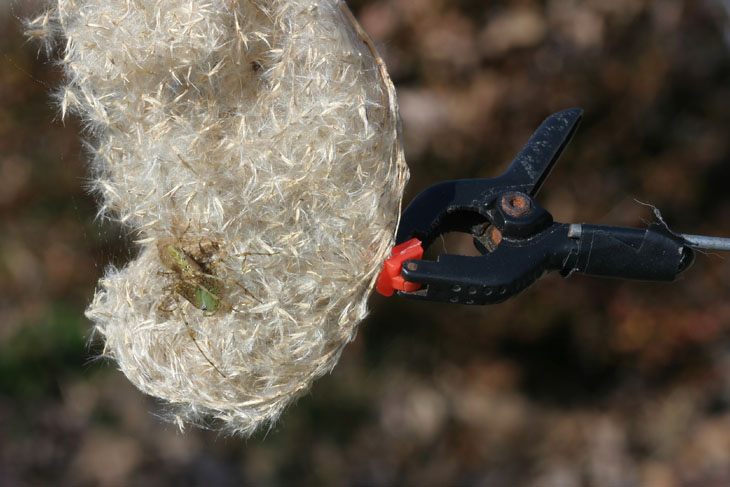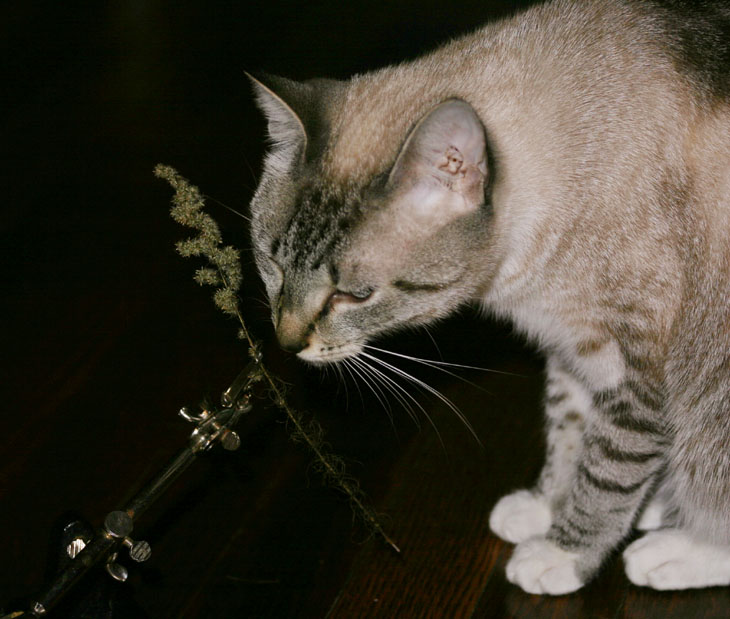This post was fostered by an exchange on Panda’s Thumb and simply needs to be said. This is an open letter to everyone who might call themselves devoutly religious, creationist, conspiracy theorist, new age or alt med supporter, paranormal or psychic believer, and so on. Or anyone that has ever used the phrase, in any form, “Science doesn’t know everything.”
It’s simple. Science has nothing to prove to you. You do not get to dictate what science is, or how it should present any evidence at all to you. And the reason for this, very simply, is that science works.
Science is a methodical process of learning, and within that method sits several distinctive functions that make us, as sure as we can humanly be, confident in our results, even negative results (which are just as important, if not more so, than the positive ones.) It is these results which ‘prove’ anything and everything that is routinely accepted as the noun, “science,” and when it comes right down to it, that’s the only thing that is needed.
Randall Munroe of xkcd, very early on in his prolific webcomic career, put it very succinctly:
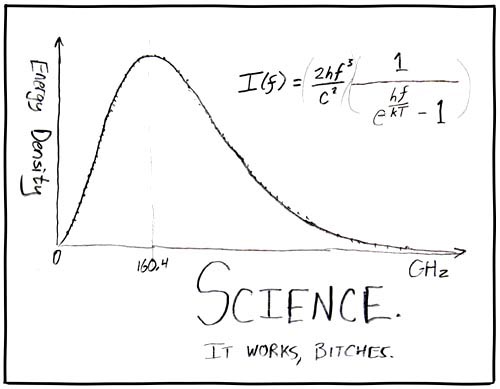
He left it up to the reader to determine what that graph and equation showed, which is part of the comic’s charm; to get the point, one has to do a little legwork. I am going to undermine this a bit, with some misgivings, by revealing that this diagrams the Cosmic Microwave Background – the leftover energy from the Big Bang theory of the origin of the universe, which is largely based on the various redshifts of the stars we can see throughout the sky. One of the consequences of the theory was that, if true, we should be able to see very faint effects of the cooling that would have been taking place from the initial high-energy state, as the energy dissipated over nearly 14 billion years. Given that time frame, this energy should be at a certain level; the problem was, we had no way to detect such low levels of energy when it was proposed, and the prediction was shelved and almost forgotten for sixteen years. A couple of radio astronomers detected the energy by accident in 1965 and could not determine what it was – the dots were connected after they brought it up to physicists at Princeton University. In other words, no one was looking for it, but found it anyway, right smack where it was predicted to be.
That’s just one of the myriad reasons why we use science, and why it has proven its value as a process. So please understand that when you claim that science has something to prove to you, you’re not just wrong, you’re both self-centered and arrogant (which may explain why you get treated as such.) Nobody really cares that you have a preference for some state of affairs, or an emotional involvement, or simply don’t understand therefore believe that science must be wrong. Your assertions, weird attempts at logic or philosophy, or selectivity over what you decide should be ‘evidence’ means nothing at all to anyone who knows why we use science. And that ‘why’ is: because to be useful it has to perform some function.
There’s a reason for this. Throughout human history, there have been millions upon millions of ideas, attempts to explain something that we witnessed. The vast majority of them were completely and utterly wrong, and the most distinctive lesson we can learn from that is how easy it is for us, as a species, to be wrong. I can predict that numerous people, who this letter is addressed to, will seize upon this as exactly their point, except that science has already gotten there ahead of you – hundreds of years ahead of you. Everything in science revolves around the simple recognition that some idea might be wrong, and in order to rule this out, we have to take pains to test it carefully. I wish the same efforts were demonstrated by everyone who denigrates science, or any aspect of it, but if that were the case there would be no point in this letter.
Most importantly, any explanation, any theory or hypothesis, any idea at all, has to lead somewhere to be anything more than an idle thought. Aliens are visiting our planet? Fine. Who are they, how did they get here, where did they come from, and what do they want? When you think you have an answer to those, then demonstrate how you know you’re not wrong. Your natural remedy is effective? Fine. How many people did it fail to work for? What do you mean, you never counted? How do you know it works, then? For any positive results you want to quote, how do you know something else wasn’t working instead? God created the universe? Fine. Who is this god, where does it live, why does it do anything, and how do you know this? Oh, you have a book? Very nice. I have several hundred – what’s your point? You do realize that millions of people before you all had their own books, and stories, and folklore, revolving around the sun and the moon and the seasons and the natural disasters – obviously their books and stories didn’t really lead anywhere, so you need to go at least that extra step to show that you’ve got a more useful idea than they had. And if your answer runs along the lines of how “everything” proves a god, which god is it proving, and how did you rule out this being the Aztec or Aborigine gods?
Double-standards that border on hypocrisy are not what any adult should be guilty of, and that’s exactly what I’m referring to here. If you think some scientific standard (or law, or theory, or whatever) isn’t working, then explain how your own preference works better. This is a minimum standard for competing scientific theories, so your superior idea should surpass this; if you haven’t bothered to even contemplate this, you deserve whatever response you receive. Finding some fault with scientific knowledge isn’t enough, not by a long shot – you can’t logically assume some other idea ‘by default.’ You need to explain not only whatever little point of evidence you’ve selected, but all of it. If it’s right, then it’s right across the board, so this should be extremely easy to demonstrate.
You might be the type that caught how the word ‘prove’ was in quotes in the third paragraph, and there’s a simple reason for this: nothing is even proven beyond the shadow of a doubt – all we can work with is the preponderance of evidence. The quotes were recognition of this fact, a bit of bare honesty that reflects how our knowledge must work. The polar opposite of this is assertion, where anyone who doesn’t know and has no way of knowing makes definitive statements anyway, even when the concept they’re promoting relies on explanations of why we cannot see the evidence we should expect – you know, like supernatural existence, or the government is hiding the technology, or cynics can suppress the effect, and so on. Anyone whose favorite concept requires excuses has no call to question any process where supporting evidence is meticulously tested.
Now for a big one. When thousands of educated people the world over are using some aspect of science on a daily basis, the chances are ridiculously, infinitesimally slim that the fatal flaw that you believe you know of did not occur to any of them, ever. So at the very least, have just a touch of humility and ask anyone if they’ve considered your idea, before you triumphantly announce you know just what’s wrong. Otherwise, once again, you deserve whatever nasty response you receive, and to be honest, probably much nastier than that. While it is certainly true that aspects of scientific knowledge have gone through corrections in the past, the people who produced these corrections were more than a little knowledgeable in the field to begin with; nowhere to be found is a correction from someone who wouldn’t pass a first-year exam in the subject. That’s the kind of stuff found in comic books, not real life. In short, it took science to correct the flaws in science – not revelation, not inspiration, not emotional surety, not astrological readings, not anecdotes from convention attendees. Not ever.
If at any time your argument includes something even vaguely related to, “It’s possible,” you’re only demonstrating the lack of evidence that you possess. Possibility is too vague to have any value – physically it means there is nothing known to prevent it, and philosophically it means everything that can be imagined, neither of which can be said to narrow down the field. For everything claimed to be ‘possible,’ it is also possible that it doesn’t exist, so as an argument it’s solely an appeal to a single perspective. Demonstrate what’s probable, and how much so, to even begin to impinge on functionality or value.
Closely related to this is the frequent selection of exceptions, such as where some scientist was actually wrong, in utter dismissal of the vast percentage of cases where science works exceptionally well. Everyone and their brother, of course, believes that they’re the lucky or special one who will be that exception, which is exactly why Las Vegas exists. Yet focusing on exceptions does nothing whatsoever to demonstrate the value of any alternate proposal; again, it’s simply an appeal to a single perspective, which demonstrates (again) the lack of something more convincing.
You are welcome, of course, to hold whatever you want to believe as a personal preference, and no one has a right to challenge that. But this should not be used as a shield when someone doesn’t agree with you. If you thought it was important enough to post about, or inform your opinions on policy, or guide your decisions in child-rearing, then you’re obviously interacting with others and we’re well out of the realm of personal choice; you are now obligated to demonstrate your reasoning. If you can’t, you should expect to be chastised or ignored. And kindly do not resort to the tired old, “People need to respect my opinion” argument, because they don’t; respect is the recognition of value, not a right that anyone has solely for existing. You get respect by earning it, and to do that, you need to convince others of the value behind your beliefs. Or, you can keep them to yourself, which is the only state that can accurately be called, ‘personal.’
If you’re not convinced, that’s fine – there’s no requirement that you should be. Science races along, believe it or not, without your support. But nobody owes you anything, and no one is obligated to try and swim upstream against your cherished beliefs. You’re not that important, and your attempt to pit your beliefs against the world has meaning only to you. If you honestly want to know, the information is readily available and very often free-of-charge. What it takes to comprehend it, however, is the honest desire for knowledge, emphasis on honest. If all you’re trying to do is shore up your own beliefs, well, that’s just insecurity, and solely your own problem.




















































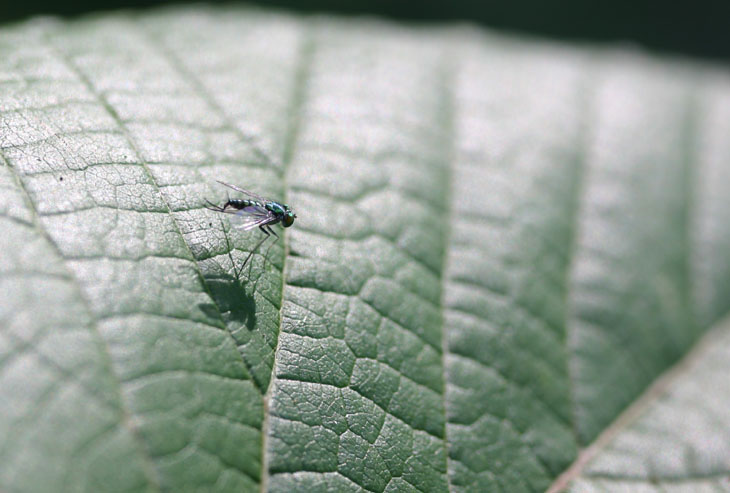
 We’ll take a quick look at closer range, too, mostly to show off the color of the eyes. It’s not that this is especially interesting, though I could call this a product of my Green Phase if I was inclined to be pretentious. But insect eye color, and some bird feathers, often depends on light angle rather than inherent pigmentation. I have often noticed that the throat color of ruby-throated hummingbirds (Archilochus colubris) doesn’t show up at all with direct flash, making it even more involved to try and get images that display this color. But I also have several arthropod images where the eyes take on a rainbow hue depending on the angle of the strobe. And so it was with this example, as I switched to augmented light for further images.
We’ll take a quick look at closer range, too, mostly to show off the color of the eyes. It’s not that this is especially interesting, though I could call this a product of my Green Phase if I was inclined to be pretentious. But insect eye color, and some bird feathers, often depends on light angle rather than inherent pigmentation. I have often noticed that the throat color of ruby-throated hummingbirds (Archilochus colubris) doesn’t show up at all with direct flash, making it even more involved to try and get images that display this color. But I also have several arthropod images where the eyes take on a rainbow hue depending on the angle of the strobe. And so it was with this example, as I switched to augmented light for further images.

 The net result of this is seen here, what I’m fairly certain is an Acanthocephala declivis, a variety of leaf-footed bug. The specimen is 30mm long, so not at all a small bug. The Girlfriend spotted it while out shopping one cold evening, sitting motionless on a sidewalk (the bug, not her.) Instead of stepping around (or on) it, she hunted about until she found a discarded drink cup, scooped it up, and brought it home for me to photograph. She had no knowledge of what it actually was, no idea of defensive mechanism or potential nastiness, but she knew I’d like it. Not to mention that it’s no longer the season for such subjects and my photography is slowing down commensurately, so I’m happy to have something to work with.
The net result of this is seen here, what I’m fairly certain is an Acanthocephala declivis, a variety of leaf-footed bug. The specimen is 30mm long, so not at all a small bug. The Girlfriend spotted it while out shopping one cold evening, sitting motionless on a sidewalk (the bug, not her.) Instead of stepping around (or on) it, she hunted about until she found a discarded drink cup, scooped it up, and brought it home for me to photograph. She had no knowledge of what it actually was, no idea of defensive mechanism or potential nastiness, but she knew I’d like it. Not to mention that it’s no longer the season for such subjects and my photography is slowing down commensurately, so I’m happy to have something to work with.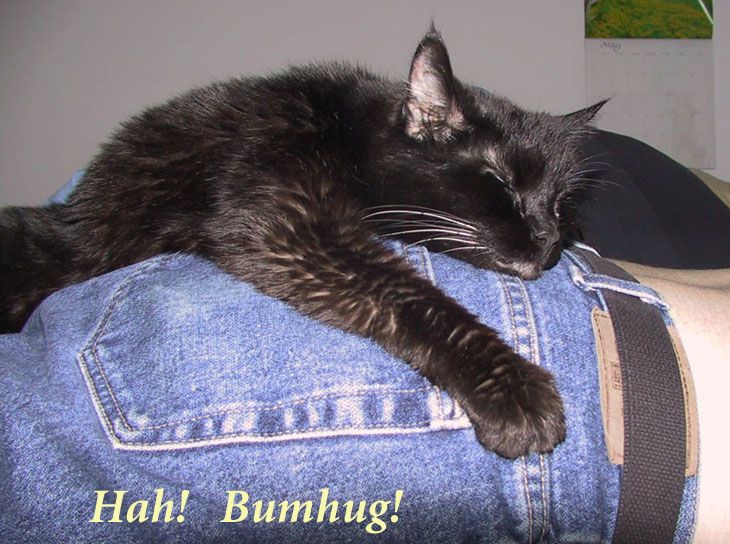

 I had to go back through my images to peg down this time frame, but ten weeks ago, a green lynx spider (Peucetia viridans) created an egg case on one of the flowering fronds of the
I had to go back through my images to peg down this time frame, but ten weeks ago, a green lynx spider (Peucetia viridans) created an egg case on one of the flowering fronds of the 

 I featured a variation of this in
I featured a variation of this in 
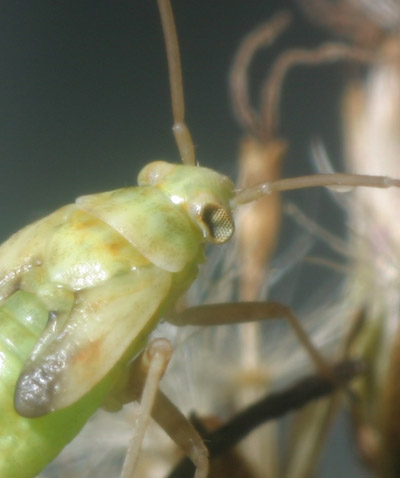 Speaking of confusion, however, we return to the broken-backed bug. I have no idea what caused this deformity – it was similar but not identical for both eye clusters – but I can’t help wondering what kind of visual input this was providing to its little insect brain. This is the one that escaped, by the way – it was the healthy specimen with almost completely developed wings that fed the lynx babbies.
Speaking of confusion, however, we return to the broken-backed bug. I have no idea what caused this deformity – it was similar but not identical for both eye clusters – but I can’t help wondering what kind of visual input this was providing to its little insect brain. This is the one that escaped, by the way – it was the healthy specimen with almost completely developed wings that fed the lynx babbies.